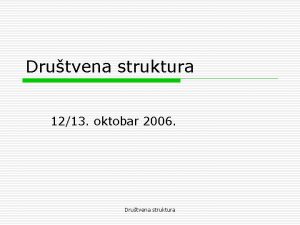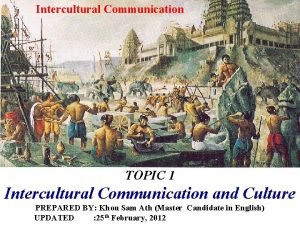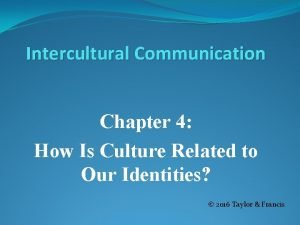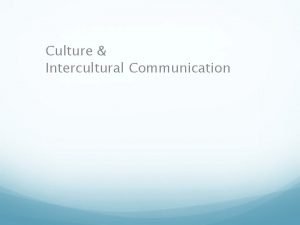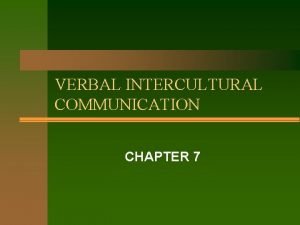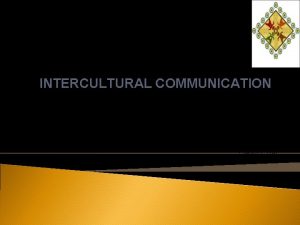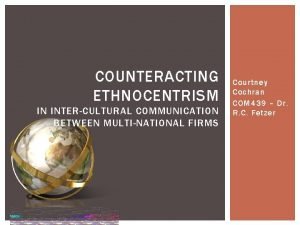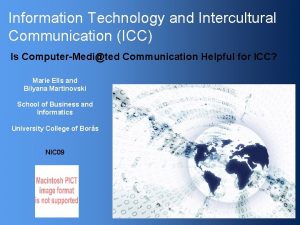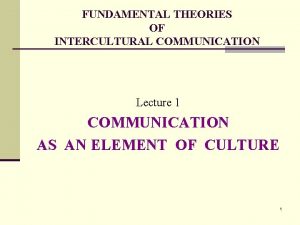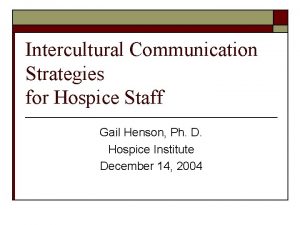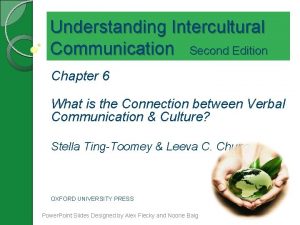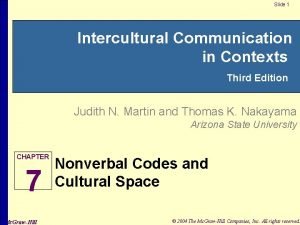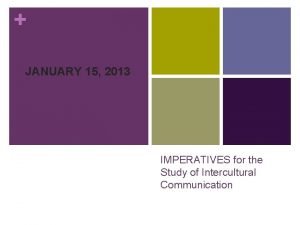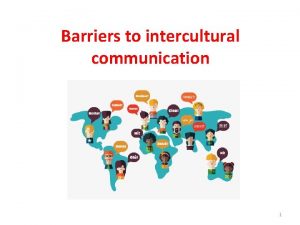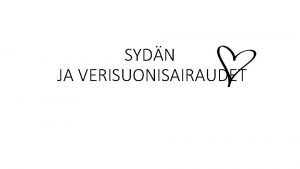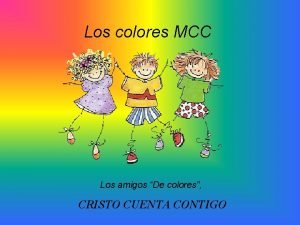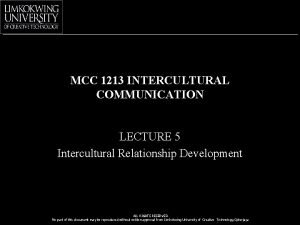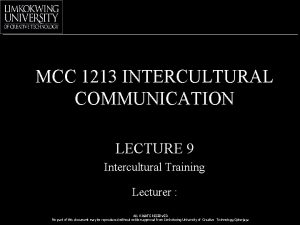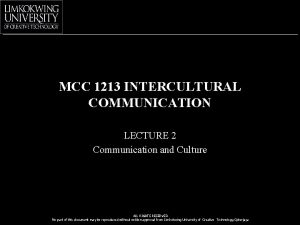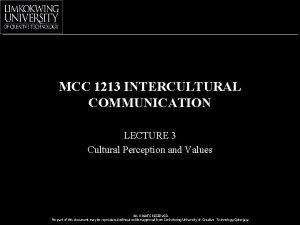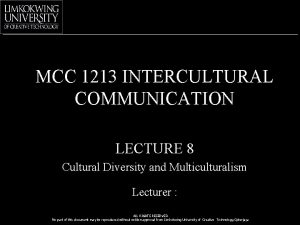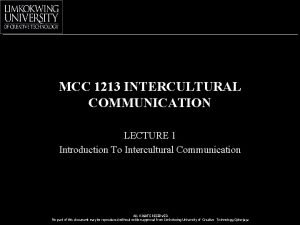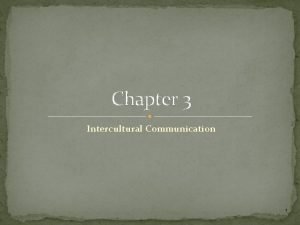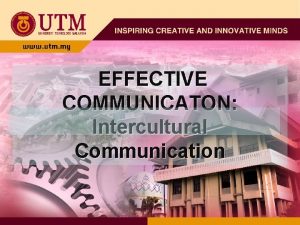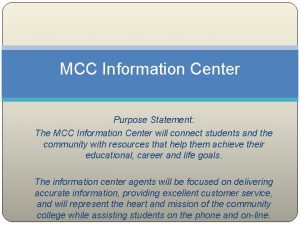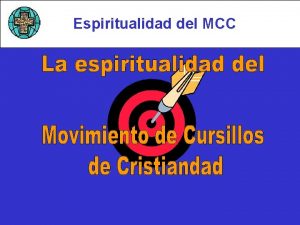MCC 1213 INTERCULTURAL COMMUNICATION LECTURE 7 Intercultural Adaptation






















- Slides: 22

MCC 1213 INTERCULTURAL COMMUNICATION LECTURE 7 Intercultural Adaptation Lecturer : ALL RIGHTS RESERVED No part of this document may be reproduced without written approval from Limkokwing University of Creative Technology, Cyberjaya

LEARNING OUTCOME • Understand the nature of culture shock and intercultural adaptation • Be able to describe the aspects, forms, symptoms and effects of culture shock • Understand the approaches and dimensions of intercultural adaptation • Understand the models for the study of intercultural adaptation. ALL RIGHTS RESERVED No part of this document may be reproduced without written approval from Limkokwing University of Creative Technology, Cyberjaya

CULTURE SHOCK AND INTERCULTURAL ADAPTATION • Intercultural adaptation refers broadly to the process of increasing our level of fitness to meet the demands of a new cultural environment (Kim, 1988) • Intercultural adaptation is a process of dealing with maladjustment within a host culture • Entrance into a new culture is generally accompanied by culture shock ALL RIGHTS RESERVED No part of this document may be reproduced without written approval from Limkokwing University of Creative Technology, Cyberjaya

Ten most difficult things we face in the process of intercultural adjustment (Furnham & Bochner, 1982) 1. Making host friends of our own age 2. Dealing with somebody who is cross and aggressive 3. Approaching others or starting up a friendship ALL RIGHTS RESERVED No part of this document may be reproduced without written approval from Limkokwing University of Creative Technology, Cyberjaya

4. 5. 6. 7. 8. Appearing in front of an audience for acting or speaking Getting to know host nationals in depth Understanding jokes, humor, and sarcasm Dealing with host nationals who stare at us Taking the initiative in keeping the conversation going ALL RIGHTS RESERVED No part of this document may be reproduced without written approval from Limkokwing University of Creative Technology, Cyberjaya

9. Spending time with host nationals we don’t know very well 10. Complaining in public or dealing with unsatisfactory service in the host culture ALL RIGHTS RESERVED No part of this document may be reproduced without written approval from Limkokwing University of Creative Technology, Cyberjaya

Cultural shock or psychological stress in a host culture. (Hammer, Gudykunst & Wiseman, 1978) 1. Frustration 2. Stress 3. Anxiety 4. Different political systems ALL RIGHTS RESERVED No part of this document may be reproduced without written approval from Limkokwing University of Creative Technology, Cyberjaya

5. 6. 7. 8. Pressure to conform Social alienation Financial difficulties Interpersonal conflict ALL RIGHTS RESERVED No part of this document may be reproduced without written approval from Limkokwing University of Creative Technology, Cyberjaya

Aspects of Culture Shock 1. Feeling of strain that comes from our attempts at psychological adjustments 2. Feeling of lost regarding friends and family, social status and possessions 3. Feeling of being rejected by or rejecting the host nationals ALL RIGHTS RESERVED No part of this document may be reproduced without written approval from Limkokwing University of Creative Technology, Cyberjaya

4. Feeling of confusion in beliefs, values, and role expectations 5. Generalized feeling of anxiety, disgust, or surprise in the face of cultural differences 6. A feeling of importance of being unable to cope with aspects of the new environment ALL RIGHTS RESERVED No part of this document may be reproduced without written approval from Limkokwing University of Creative Technology, Cyberjaya

EFFECTS OF CULTURE SHOCK Positive: • A transitional process of movement, gradually become aware • May contribute to individual growth • Can create an environment and serve as motivational force ALL RIGHTS RESERVED No part of this document may be reproduced without written approval from Limkokwing University of Creative Technology, Cyberjaya

• A welcome sense of challenge and achievement • Produces new ideas for future unfamiliar situation Negative: • Constitutes an imbalancing experience • Sorting cultural: differences may take a long time or may prove impossible ALL RIGHTS RESERVED No part of this document may be reproduced without written approval from Limkokwing University of Creative Technology, Cyberjaya

DIMENSIONS OF INTERCULTURAL ADAPTATION • Alienation - Limit our social circle to host culture and seek our own national for social enjoyment • Marginality - Be functional and superficial with host nationals, rather than personal or intimate ALL RIGHTS RESERVED No part of this document may be reproduced without written approval from Limkokwing University of Creative Technology, Cyberjaya

• Acculturation - Make intimate friends with the host nationals and gradually to replace some elements of our original culture with elements of the host culture • Duality - Ability to accommodate to both the original and the host culture while living in a new environment ALL RIGHTS RESERVED No part of this document may be reproduced without written approval from Limkokwing University of Creative Technology, Cyberjaya

STAGES OF INTERCULTURAL ADAPTATION U- Curve pattern • Honeymoon Period – fascination with the new culture and by the excitement we encounter in the host culture • Crisis Period – Face challenges of the new culture on a day-to-day basis ALL RIGHTS RESERVED No part of this document may be reproduced without written approval from Limkokwing University of Creative Technology, Cyberjaya

• Adjustment period – Begin to learn and how to respond adopt appropriately to new environmental • Biculturalism period – Freedom and capacity for dual cultural identity ALL RIGHTS RESERVED No part of this document may be reproduced without written approval from Limkokwing University of Creative Technology, Cyberjaya

W – Curve Pattern • Share feelings about experience abroad with sympathetic friends or relatives • Ask questions about the home culture • Ask friend to help you figure items like new slang, new social events etc • Join different social group as religious rituality, clubs to gain more information • Find people from your original culture with international experience ALL RIGHTS RESERVED No part of this document may be reproduced without written approval from Limkokwing University of Creative Technology, Cyberjaya

MODEL OF INTERCULTURAL ADAPTATION A. Dialectical Model (Anderson, 1994) • Cultural adaptation is a cyclical and recursive process • Our responses will create our own adjustment patterns • Drive and motivation is the force that move us ALL RIGHTS RESERVED No part of this document may be reproduced without written approval from Limkokwing University of Creative Technology, Cyberjaya

THE MODEL PROPOSES 6 PRINCIPLES • Six principles: 1. A motivated, goal-oriented process 2. Intercultural adaptation and learning processes are reciprocal and interdependent 3. Implies a stranger-host relationship 4. A cynical, continuous, and interactive process 5. Is ongoing 6. Implies personal development ALL RIGHTS RESERVED No part of this document may be reproduced without written approval from Limkokwing University of Creative Technology, Cyberjaya

B. Transformative Learning Model (Taylor, 1994) Ten-phase transformation process: 1. A disorienting dilemma 2. Self-examination with feelings of guilt or shame 3. A critical assessment ALL RIGHTS RESERVED No part of this document may be reproduced without written approval from Limkokwing University of Creative Technology, Cyberjaya

4. Recognition that one’s discontent and process of transformation are shared and that others have negotiated a similar change 5. Exploration of options for new roles, relationships and actions 6. Planning of a course of action 7. Acquisition of knowledge and skills for implementing our plans ALL RIGHTS RESERVED No part of this document may be reproduced without written approval from Limkokwing University of Creative Technology, Cyberjaya

8. Provisional adoption of new roles 9. Building of competence and self-confidence in new roles and relationships. 10. A reintegration into one’s new perspective. ALL RIGHTS RESERVED No part of this document may be reproduced without written approval from Limkokwing University of Creative Technology, Cyberjaya
 1213 znacenje
1213 znacenje 01:640:244 lecture notes - lecture 15: plat, idah, farad
01:640:244 lecture notes - lecture 15: plat, idah, farad Barriers in intercultural communication
Barriers in intercultural communication Example of a low context culture
Example of a low context culture Intercultural communication questions
Intercultural communication questions Ascription and avowal
Ascription and avowal Intercultural communication meaning
Intercultural communication meaning Intercultural communication notes
Intercultural communication notes Staircase model of intercultural communication
Staircase model of intercultural communication Preview of main points
Preview of main points Nonverbal intercultural communication
Nonverbal intercultural communication Intercultural communication conclusion
Intercultural communication conclusion Ethnocentrism intercultural communication
Ethnocentrism intercultural communication Intercultural communication model
Intercultural communication model Technology and intercultural communication
Technology and intercultural communication The totality of a groups thought experiences and patterns
The totality of a groups thought experiences and patterns Strategies for improving intercultural communication
Strategies for improving intercultural communication Linear vs relational worldview
Linear vs relational worldview Intercultural communication in contexts
Intercultural communication in contexts Demographic imperative intercultural communication
Demographic imperative intercultural communication 4 barriers of intercultural communication
4 barriers of intercultural communication Nitroglycerin orion
Nitroglycerin orion Los amigos de colores
Los amigos de colores
